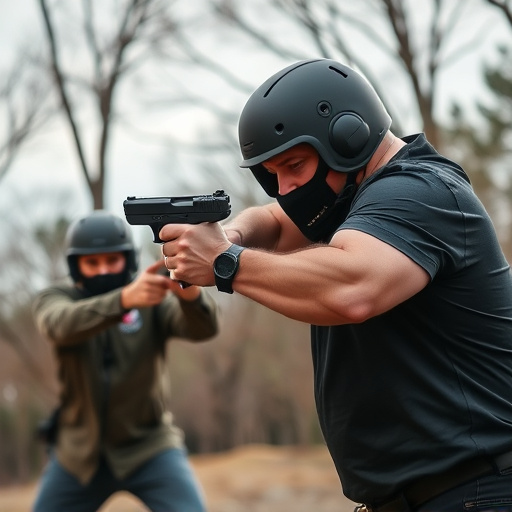Police-Grade Stun Guns: Features, Safety, Legalities, and Future Trends
The Neuromuscular Effects of Stun Devices, like stun guns and electronic control devices (ECDs), cau…….
The Neuromuscular Effects of Stun Devices, like stun guns and electronic control devices (ECDs), cause brief, powerful disruptions in muscle function through electrical shocks. These non-lethal weapons are effective for self-defense and law enforcement due to their ability to induce muscle spasms and temporary paralysis. Police-grade stun guns feature advanced safety mechanisms, durability, and adjustable voltage settings, while proper training is crucial for safe and accurate deployment. Global legal status varies, with many regions allowing their use under strict guidelines. Future advancements focus on precision and safety, aiming to optimize neuromuscular disruption through innovative technology like adaptive algorithms, lightweight materials, and refined electrical current patterns.
“Discover the power and precision of police-grade stun guns, designed for professional use. This comprehensive guide explores the critical role these devices play in law enforcement, delving into their neuromuscular effects as a key feature. From understanding how they disrupt muscle function to examining advanced safety mechanisms and legal considerations, we uncover the essential aspects of stun gun technology. Get ready to navigate the world of police-grade stun devices, where every second counts.”
- Understanding Neuromuscular Disruption: How Stun Guns Work
- Key Features of Police-Grade Stun Devices
- Safety Mechanisms and User Training
- Legal Considerations and Use Cases
- Evolving Technology: Future Trends in Stun Gun Design
Understanding Neuromuscular Disruption: How Stun Guns Work

Stun guns, also known as electronic control devices (ECDs), work by inducing a brief period of neuromuscular disruption in their target. This disruption is achieved through a powerful electrical current that flows from the stun gun’s electrodes to the person’s body. The current interferes with the nervous system’s ability to send signals to muscles, causing them to contract involuntarily and leading to loss of balance and consciousness for a short period.
The Neuromuscular Effects of Stun Devices are swift and powerful. When activated, the stun gun delivers an electric shock that overloads motor nerve fibers, resulting in muscle spasms and temporary paralysis. This reaction occurs even if the person is wearing protective gear or attempting to block the shock, making stun guns a highly effective non-lethal self-defense tool for law enforcement and individuals seeking personal protection.
Key Features of Police-Grade Stun Devices

Police-grade stun guns are designed with advanced features to ensure their effectiveness and reliability in high-pressure situations. One of the key aspects is their ability to deliver a powerful neuromuscular shock, which temporarily incapacitates the target without causing permanent harm. This technology disrupts the electrical signals transmitted by the nervous system, leading to muscle convulsions and a loss of balance. The precise amount of energy delivered is critical; it must be strong enough to subdue an individual but not so intense as to cause severe or lasting damage.
Additionally, these stun devices often incorporate safety features and user-friendly designs. Some models have digital controls for adjustable voltage settings, allowing officers to tailor the shock intensity based on the situation and target’s resistance. A bright LED flash is another common attribute, providing a disorienting visual effect that complements the neuromuscular impact. The durability and water resistance of police-grade stun guns are also essential considerations, ensuring their longevity in various environments.
Safety Mechanisms and User Training

Stun guns, while powerful tools for self-defense, come equipped with a range of safety mechanisms designed to prevent accidental discharges and ensure user safety. These devices operate by delivering a high-voltage, low-current electric shock that disrupts the neuromuscular system, temporarily incapacitating the target. Advanced stun guns employ features like automated safety switches, which require a firm trigger pull and a clear line of sight, minimizing the risk of unintended use. Some models also feature built-in alarms and LED flashlights for added awareness and safety during low-light conditions.
Proper user training is paramount when it comes to handling stun guns safely and effectively. Training should cover not only the physical operation of the device but also the strategic deployment of neuromuscular effects. Users must learn to assess threat levels, maintain proper distance, and aim for specific target areas to optimize the stun gun’s effectiveness while minimizing collateral damage. Regular practice sessions under professional supervision are crucial to developing muscle memory and ensuring users can respond swiftly and accurately in real-life scenarios.
Legal Considerations and Use Cases

The legal landscape surrounding stun guns varies significantly across jurisdictions, reflecting a delicate balance between public safety and individual rights. In many regions, law enforcement agencies and qualified individuals can legally carry stun devices under specific circumstances. These regulations often delineate factors such as power output, intended use, and the user’s authorization to employ such force. Understanding these legal considerations is paramount for responsible ownership and deployment.
Stun guns, or electroshock weapons, function by delivering a high-voltage, low-current electrical pulse that disrupts the neuromuscular system, temporarily paralyzing the target. This non-lethal approach has proven valuable in various use cases, including crowd control, self-defense, and law enforcement operations. Their effectiveness lies in the neuromuscular effects, allowing users to subdue individuals without causing permanent harm. However, it’s crucial to emphasize that their use should adhere to strict guidelines, ensuring minimal injury and proportionate response.
Evolving Technology: Future Trends in Stun Gun Design

The evolution of stun gun technology is guided by a deep understanding of the neuromuscular effects these devices have on their targets. As we move into the future, designers are expected to incorporate advanced features that enhance safety, effectiveness, and ease of use. One prominent trend is the development of smarter, more precise stun guns that can adapt to different body types and sizes, ensuring optimal shock distribution for maximum neuromuscular disruption. These devices might utilize sophisticated algorithms and sensor technology to assess the target’s physical attributes and adjust the electrical impulse accordingly.
Additionally, researchers are exploring new materials and energy sources to improve performance. High-density, lightweight materials could enhance the weapon’s impact, while advanced battery technologies could provide longer durations between charges. The integration of these innovations will not only make stun guns more effective but also contribute to their reduced weight and size, making them easier to carry and use in a variety of situations. Moreover, focusing on minimizing off-target effects by refining the electrical current patterns and pulse widths will further enhance the safety profile of these devices, aligning with the ongoing goal of public safety and the responsible use of force.
Stun guns, with their ability to temporarily disable individuals through neuromuscular disruption, have become valuable tools for police and self-defense enthusiasts alike. As technology advances, future designs will likely incorporate enhanced safety features, improved activation mechanisms, and more efficient power sources, ensuring their continued effectiveness while mitigating potential risks. Understanding the neuromuscular effects and legal implications is crucial for responsible use, making these devices a significant addition to personal and professional security measures.


